

Titan. Saturn. "Saturn's Ring System Rains Water into Atmosphere" O'Donoghue said the ring's effect on electron densities is important because it explains why, for many decades, observations have shown electron densities to be unusually low at some latitudes at Saturn. "The ring particles affect which species of particles are in this part of the atmospheric temperature. " In the early 1980s, images from NASA's Voyager spacecraft showed two to three dark bands on Saturn and scientists theorized that water could have been showering down into those bands from the rings. Those bands were not seen again until 2011 when the the team observed the planet with Keck Observatory's NIRSPEC, a unique, near-infrared spectrograph that combines broad wavelength coverage with high spectral resolution, allowing the observers to clearly see subtle emissions from the bright parts of Saturn.
What they observed instead was a series of light and dark bands with a pattern mimicking the planet's rings. This is a significantly larger area than suggested by the Voyager images. SaturnEclipsesTheSun. Saturn's Shockwaves Reach Supernova Force. Scientists are particularly interested in "quasi-parallel" shocks, where the magnetic field and the "forward"-facing direction of the shock are almost aligned, as may be found in supernova remnants.

Pac-Man Seen Near Saturn - Space News. November 26, 2012 Image Caption: Scientists with NASA's Cassini mission have spotted two features shaped like the 1980s video game icon "Pac-Man" on moons of Saturn.
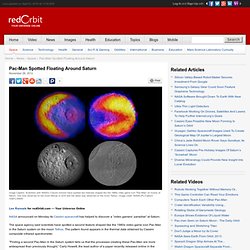
One was observed on the moon Mimas in 2010 and the latest was observed on the moon Tethys. Image credit: NASA/JPL-Caltech/GSFC/SWRI Lee Rannals for redOrbit.com — Your Universe Online NASA announced on Monday its Cassini spacecraft has helped to discover a “video gamers’ paradise” at Saturn. The space agency said scientists have spotted a second feature shaped like the 1980s video game icon Pac Man in the Saturn system on the moon Tethys. “Finding a second Pac-Man in the Saturn system tells us that the processes creating these Pac-Men are more widespread than previously thought,” Carly Howett, the lead author of a paper recently released online in the journal Icarus, said in a statement. Strongest evidence yet indicates Enceladus hiding saltwater ocean. This image shows icy spray spewing from Saturn's moon, Enceladus.
Credit: NASA/JPL/Space Science Institute. Plume Zoom. Flying over Enceladus' southern plumes (click to play) Check this piece of coolness out… it’s an animation made of 30 frames of raw image data captured by Cassini during its August 13th flyby of Enceladus.
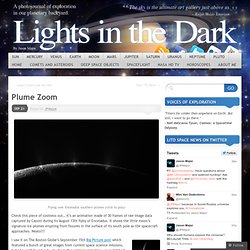
It shows the little moon’s signature ice plumes erupting from fissures in the surface of its south pole as the spacecraft approaches. Neato!!! Enceladus' Icy Geysers I saw it on The Boston Globe’s September 15th Big Picture post which featured a bunch of great images from current space science missions, but I haven’t found out yet where the original animation was published. (If it’s not animating just give it a click. :) ) Image: NASA/JPL/Space Science Institute Like this post? There has been an error. Saturn's Moon Phoebe - Solar System Reference Library. Saturn’s moon Phoebe — Phoebe is the outermost of Saturn’s known moons.
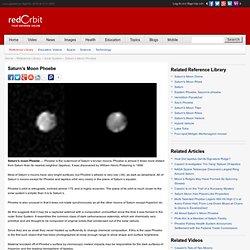
Phoebe is almost 4 times more distant from Saturn than its nearest neighbor (Iapetus). It was discovered by William Henry Pickering in 1898. Saturn's Moons - Images. Possible Subsurface Ocean Beneath Saturn Moon Dione - Space News. May 30, 2013 Image Credit: The Cassini spacecraft looks down, almost directly at the north pole of Dione.

The feature just left of the terminator at bottom is Janiculum Dorsa, a long, roughly north-south trending ridge. Credit: NASA/JPL/Space Science Institute Brett Smith for redOrbit.com – Your Universe Online Once considered to be an afterthought when it came to Saturn´s moons, scientists now believe Dione likely had an active geological history after analyzing data sent back from NASA´s Cassini spacecraft. “A picture is emerging that suggests Dione could be a fossil of the wondrous activity Cassini discovered spraying from Saturn’s geyser moon Enceladus or perhaps a weaker copycat Enceladus,” said Cassini team leader Bonnie Buratti of NASA’s Jet Propulsion Laboratory in Pasadena, California. Cassini´s images suggest that Dione could join Saturn’s other moons that are believed to have subsurface activity, Enceladus and Titan. Source: Brett Smith for redOrbit.com - Your Universe Online. Saturn 'burps' after large storm. Nasa’s Cassini spacecraft has tracked the aftermath of a rare massive storm on Saturn.

Data reveal record-setting disturbances in the planet’s upper atmosphere long after the visible signs of the storm abated, in addition to an indication the storm was more forceful than scientists previously thought. Data from Cassini’s composite infrared spectrometer (CIRS) instrument revealed the storm’s powerful discharge sent the temperature in Saturn’s stratosphere soaring 66 degrees Celsius above normal. At the same time, researchers at Nasa’s Goddard Space Flight Centre detected a huge increase in the amount of ethylene gas, the origin of which is a mystery. Ethylene, an odourless, colourless gas, isn’t typically observed on Saturn. On Earth, it is created by natural and man-made sources. Hot Cyclones Churn At Both Ends Of Saturn. Despite more than a decade of winter darkness, Saturn's north pole is home to an unexpected hot spot remarkably similar to one at the planet's sunny south pole.
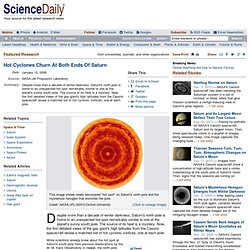
Astrophile: Saturn's egg moon Methone is made of fluff - space - 17 May 2013. Astrophile is our weekly column on curious cosmic objects, from the solar system to the far reaches of the multiverse Object: Oval moon MethoneLocation: Saturn's rings Out among Saturn's menagerie of moons, a shiny white egg rests in a nest of ice crystals.
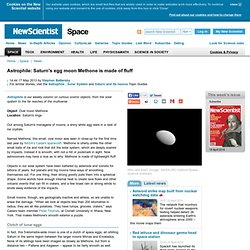
Named Methone, this small, oval moon was seen in close-up for the first time last year by NASA's Cassini spacecraft. Methone is utterly unlike the other small balls of ice and rock that dot the solar system, which are deeply scarred by impacts. Instead it is smooth, with not a hill or pockmark in sight. Objects in our solar system have been battered by asteroids and comets for billions of years, but planets and big moons have ways of smoothing themselves out. Small moons, though, are geologically inactive and airless, so are unable to erase the damage. Salt in Enceladus geyser points to liquid ocean - space - 29 April 2009. Two Moons Passing in the Night - Image of the Day - Images.
Saturn may have snagged Pluto's cousin, turned it into a moon. Saturn's moon Phoebe might be a planetesimal—a remnant of the rocky building blocks of the planets in our Solar System.

A new study by Julie C. Castillo-Rogez et al. from Cassini spacecraft data indicates that Phoebe dates back to the very earliest days of the Solar System. Based on surface features and evidence that the moon is significantly more dense than the larger Saturnian satellites, the astronomers argue that Phoebe likely formed much farther from the Sun then fell inward, where it was snagged by Saturn's gravity.
Using detailed observations from Cassini and Earth-based telescopes, in combination with detailed computer simulations, Castillo-Rogez et al. determined that Phoebe began as a spherical body. Based upon the density and comparison with bodies of similar size, Phoebe may have a rocky core surrounded by a porous icy shell. Cassini detects hint of fresh air at Dione. Nasa's Cassini spacecraft has "sniffed" molecular oxygen ions around Saturn's icy moon Dione for the first time, confirming the presence of a very tenuous atmosphere.

The oxygen ions are quite sparse – one for every 11 cubic centimetres of space or about 90 000 per cubic metre – show that Dione has an extremely thin neutral atmosphere. At the Dione surface, this atmosphere would only be as dense as Earth's atmosphere 480 kilometres above the surface. The detection of this faint atmosphere, known as an exosphere, is described in a recent issue of the journal Geophysical Research Letters. Oxygen detected on Saturn's moon Rhea.
A spacecraft has tasted oxygen in the atmosphere of another world for the first time while flying low over Saturn's icy moon, Rhea. Nasa's Cassini probe scooped oxygen from the thin atmosphere of the planet's moon while passing overhead at an altitude of 97km in March this year. Until now, wisps of oxygen have only been detected on planets and their moons indirectly, using the Hubble space telescope and other major facilities.
Instruments aboard Cassini revealed an extremely thin oxygen and carbon dioxide atmosphere that is sustained by high-energy particles slamming into the moon's surface and kicking up atoms, molecules and ions. Astronomers have counted 62 moons orbiting Saturn. At 1500km wide, Rhea is the second largest and is thought to be made almost entirely of ice. Alien Voices of Saturn? NASA Radio Recordings from the Rings. The Eerie Sounds Of Saturn.